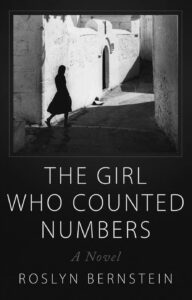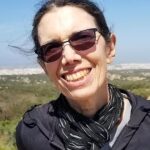 Novelist Roslyn Bernstein joins me today to talk about her new historical fiction, The Girl Who Counted Numbers.
Novelist Roslyn Bernstein joins me today to talk about her new historical fiction, The Girl Who Counted Numbers.
Welcome, Roslyn, please tell us a little bit about yourself.
I have been a storyteller all her life, sometimes working for a true account in the narrow sense as a journalist when it’s reporting or history, and sometimes in a wider, more resonant sense when composing poetry, short stories, or a novel.
As a journalist, I have reported in-depth cultural stories for venues including Guernica, Tablet, Arterritory, and Huffington Post. While reporting on all forms of art and architecture, documentary photography has been a major subject of my writing and teaching since the 1970s. Sixty of my online pieces were reprinted in an anthology: Engaging Art: Essays and Interviews from around the Globe.
I am the author of a collection of linked-fictional tales, Boardwalk Stories, set in a seaside community during the 1950s, and the co-author of a history of SoHo, Illegal Living: 80 Wooster Street and the Evolution of SoHo, which focuses on one building to tell the story of SoHo’s transformation from a manufacturing district to a live-work arts community.
Please tell us about your current release.
This novel is the story of Susan Reich, an independent, Jewish-American girl who leaves for Israel to solve a family mystery. The hunt for any evidence of her missing uncle takes her to unexpected places where she must confront parts of the past she never knew. With the infamous Adolf Eichmann trial happening in the backdrop, Susan begins unraveling these complex layers of history and is drawn into the tense political climate of a post-Holocaust Israel. As she gets more and more involved in the struggles of her Israeli and Jewish-Moroccan friends, she explores awakening emotions and discovers her own interest in truth, justice, and activism.
What inspired you to write this book?
I spent seven months in Jerusalem in 1961, where I listened to the stories of immigrants and survivors and daydreamed about their meanings. This was the source of inspiration for The Girl Who Counted Numbers. I have been attentive to historical accuracies of time and place but the story of Susan Reich, her family, and friends is fictional. The cover untitled photograph was chosen as an evocation of just that time and place. This photograph was made about 1960 by an Israeli photographer, Liselotte Grschebina, whose archive is in the collection of The Israel Museum.
Excerpt from The Girl Who Counted Numbers:
‘I’ve found the perfect solution,’ he said, reading the headline aloud: ‘How American Jews Claim Their Jewish Heritage in Israel.’ Beneath the headline, there was a photo of a group of young people standing in front of the SS Jerusalem II, a ship that sailed from New York to Haifa for the Zim Lines. ‘That could be you,’ he said, pointing to the picture. For the first time in a week, he was actually smiling. Her father had come up with a new plan, one that he approved of. ‘I’ll send you to Israel.’
What exciting project are you working on next?
I am working on a collection of my poetry, Sleeping With My Eyes Open.
 When did you first consider yourself a writer?
When did you first consider yourself a writer?
I began writing little stories as soon as I could print letters and continued through junior high school. The stories were often illustrated. They dealt with objects I saw on the street, people who passed me by; some were mysteries, some were magical realism. In high school I was the editor of the literary magazine, writing poetry and short fiction. After graduating college, I spent two years working for Esquire Magazine before going to graduate school for a MA and a Ph.D.
Do you write full-time? If so, what’s your workday like? If not, what do you do other than write and how do you find time to write?
After graduate school, I joined the journalism and creative writing faculty at Baruch College, CUNY. During my teaching years I wrote hundreds of freelance articles, many on funding for the arts and cultural reporting. I interviewed artists and gallery owners, and I wrote critical reviews of various exhibits around the world. Since retiring, I spend my time writing, doing ceramics (in particular making ceramic totem poles), gardening, and traveling.
What would you say is your interesting writing quirk?
I often have the ending in mind when I begin a story. Things do change but having some sense of where I am going helps me move the narrative forward. And I use up hundreds of yellow post-its. I constantly write notes to myself on them and stick them on pages as I write.
As a child, what did you want to be when you grew up?
At first, I wanted to be a ballerina, but vertigo interfered. After that I wanted to be a physicist, then a doctor, and finally a journalist and an author.
Anything additional you want to share with the readers?
The story in The Girl Who Counted Numbers contains a unique surprise. Many readers have told me that they cried at the end. The book tells a story of the Holocaust which is not about the horrors, but rather about love.
